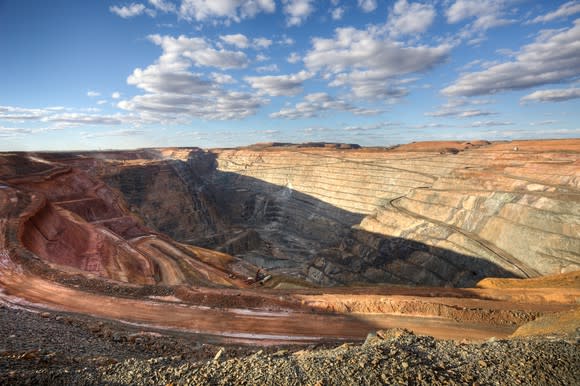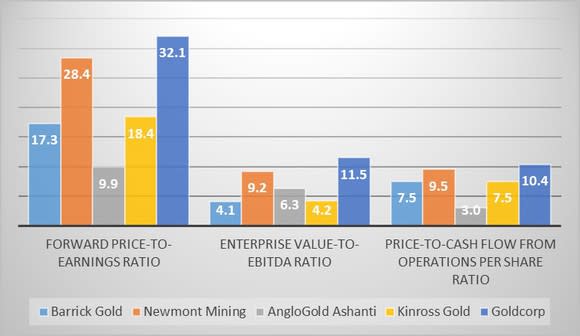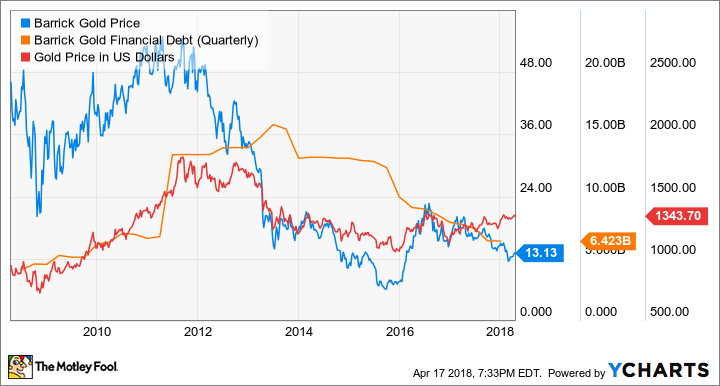What Investors Need to Know About Barrick Gold Corp Stock
Investors buy gold and gold-related stocks based on the belief that the price of the precious metal -- and therefore their chosen investment vehicle -- will rise in value. While there is often a direct correlation between the price of gold and some gold ETFs, that hasn't always been the case with gold mining stocks like Barrick Gold (NYSE: ABX). In fact, for most of the past several years, Barrick Gold stock has vastly underperformed the price of gold due to several missteps by the company.
Barrick Gold's management team, however, is working hard to correct those past misdeeds. If successful, the company's turnaround plan could turn it into a gold mine of value for investors in the coming years making it an interesting stock for gold bulls to consider.

Barrick Gold stock has been nothing but a money pit for investors in recent years. Image source: Getty Images.
Digging into Barrick Gold
Barrick Gold is the largest gold miner in the world, producing 5.32 million ounces of the precious metal in 2017. While that was down from 5.53 million ounces in 2016 -- and well off the company's peak from a few years ago -- it was enough to edge out Newmont Mining's (NYSE: NEM) 5.27 million ounces for the top spot. In addition to gold, Barrick also produced 413 million pounds of copper, which -- while significant -- pales in comparison to Freeport-McMoRan's 3.7 billion pounds, enough to make it the world's largest publicly traded copper producer.
Given how much gold Barrick produces, it's no surprise to see that this precious metal supplies it with the bulk of its revenue. In 2017, Barrick Gold hauled in $8.4 billion of revenue, with 91% of that coming from gold, 7% from copper, and just 2% from other sources, which includes by-products produced from its gold and copper mines. That's a much higher gold weighting than fellow gold producer Goldcorp (NYSE: GG), for example, which only received 74% of its revenue from the precious metal in 2017. It's a noteworthy difference for gold investors because it implies that Barrick Gold has more exposure to the price of gold than some rivals, meaning its profitability and stock price should rise and fall to a greater extent when gold makes a big move.
Barrick Gold mines these metals from operations that span the globe. However, the bulk comes from its stakes in four core gold mines. The company's most important asset is Barrick Nevada, which is an integrated gold mine that combines its Cortez and Goldstrike properties in Nevada. In 2017, the company pulled out 2.3 million ounces of gold from Barrick Nevada, which was 43% of total production. This operation also boasts low all-in sustaining costs (ASIC) -- the all-encompassing production cost -- of $624 an ounce, which was below the company average of $750 in 2017.
The second-largest contributor is Pueblo Viejo in the Dominican Republic, which is one of the largest gold mines in the world. Barrick Gold operates this mine as 60-40 joint venture (JV) with Goldcorp. In 2017, it supplied Barrick with 650,000 ounces of gold, good for 12% of its total production. This mine also features below-average costs of $525 an ounce.
While not one of its core mines, another notable one is the Kalgoorlie "Super Pit" in Australia, which is one of the largest open-pit mines in the world. Barrick Gold held this mine through a 50-50 JV with Newmont Mining and received 368,000 ounces from its share of the mine's production in 2017. Joint ventures like these are common in the mining industry because they help companies share the initial development risk as they build new mines.
In addition to those gold mines, Barrick Gold also owns stakes in three copper mines. The biggest contributor is the Lumwana mine in Zambia, which produced 256 million pounds of copper last year. The company also owns 50% stakes in the Zaldivar mine in Chile and Jabal Sayid in Saudi Arabia. While copper helps diversify Barrick's revenue sources and increase its growth prospects, it's overall contribution remains small.
Climbing the gold-mining leaderboard one deal at a time
Peter Munk initially created Barrick to invest in the oil and gas industry in the early 1980's, calling it Barrick Petroleum. However, after quickly losing big in the oil market due to slumping crude prices, he turned his sights to the gold market where he saw an opportunity. He renamed the company Barrick Resources and quickly exited the oil market. He took his gold venture public on the Toronto Stock Exchange in 1983 and would go on to buy several gold mines and mining companies in the years that followed in both Canada and the U.S., including purchasing the Goldstrike mine in 1986.
These acquisitions steadily moved the company up the leaderboard. Barrick would go on to stake its claim as the third-largest gold producer in the world in 1994 after buying Lac Minerals. The company moved up one more notch in 2001 when it purchased Homestake Mining Company for $2.3 billion. Barrick finally claimed to the top spot five years later when it paid $10.4 billion to buy Placer Dome. These acquisitions not only added producing mines but development projects. Placer Dome, for example, brought Pueblo Viejo into the fold, which at the time was under development.
Barrick Gold has remained active in the mergers and acquisitions market since it vaulted to the top spot more than a decade ago. Its most recent deal of note was the purchase of Equinox Minerals for $7.69 billion in 2011. However, instead of bolstering the company's lead in the gold market, Equinox diversified it into copper.
The cost of becoming king of the hill
The purchase of Equinox Minerals was a bad idea in hindsight because it loaded the company with debt just as commodity prices tumbled. That buying binge would eventually take a toll on Barrick Gold's balance sheet because the company had taken on a mountain of debt to become a leading gold and copper producer. By 2013, the company had more than $15 billion in debt outstanding, which began weighing on its stock price as gold started falling from its peak:
That led the company to undertake a plan to sell off some of its higher cost non-core mines so that it could chip away at debt. The company would go on to complete several mine sales and joint ventures, which pushed debt down to $6.4 billion by the end of 2017. Barrick hopes to get that number to about $5 billion by the end of 2018.
However, while the asset sales have helped improve the mining giant's balance sheet, they've also started cutting away at its lead over Newmont Mining as the world's largest gold producer. In fact, it will likely cede that title this year given the production forecasts of both companies. While Barrick initially thought that it would benefit from being the biggest miner due to lower costs from the greater scale, that hasn't been the case, which is why it's now willing to give up that title.
The $5 billion hole in the ground
Before we look ahead, no review of Barrick Gold would be complete without mentioning the company's biggest misstep: The development of the Pascua-Lama mine that straddles the border of Argentina and Chile. It's one of the largest untapped gold reserves in the world and would feature an ultralow AISC if complete. However, Barrick has wasted billions of dollars on that mine over the years with nothing to show.
The company initially started developing it in 2004 and had planned to invest about $1 billion. However, by the time Barrick began work in 2009, the company estimated it would cost between $2.8 billion to $3 billion. Cost estimates continued escalating and reached $8.5 billion by 2012. The company decided to suspend work early the next year after sinking $5 billion into the yet-unfinished project.
Barrick Gold is still trying to figure out the best way to develop this resource, which, while an option for the future, doesn't currently meet the company's risk/reward criteria. Not only does it have to overcome some major logistical issues, but Chile has ordered the company to close its facilities in that country.
The new Barrick Gold
Barrick Gold invested billions of dollars over the years to become the world's largest gold producer. However, that growth hasn't created any value for investors. In fact, Barrick Gold's shares currently sit nearly 40% below where they traded on the day the company made the production doubling move to acquire Lac Minerals in 1994, which is stunning underperformance considering that the price of gold is up 250% over that time frame.
That poor performance is leading Barrick to shift its focus away from growing gold production and toward increasing cash flow. The miner aims to build a business that can sustainably deliver free cash flow at a gold price of $1,000 an ounce. That starts with reducing costs not only through operational improvements but by jettisoning higher-cost mines and using the proceeds to retire debt. The company's strategy also features investing in high-return capital projects that meet a strict return hurdle and focusing on growing cash flow instead of production.
As a result of this new strategy, Barrick Gold only expects to produce 4.5 million to 5 million ounces of gold in 2018, with output slipping further to an average of 4.2 million to 4.6 million ounces from 2019 through 2022. The company will likely lose its crown as the world's largest gold producer to Newmont Mining in 2018 since its peer sees output averaging between 4.9 million to 5.4 million ounces over the next two years. However, Barrick believes its smaller production base will be more profitable because it should benefit from a lower AISC of $750 to $875 an ounce through 2022, which would enable the company to generate free cash flow even if gold falls to $1,000 an ounce.
Does this make Barrick Gold stock a buy?
In the past, Barrick Gold made the disastrous mistake of focusing on building a gold mining empire instead of growing the value of the company. Those value-destroying ways, however, appear to be in the rearview mirror. The company has already closed or sold several of its less profitable mines to focus on those that create the most value. This approach should see the company generate excess cash even if gold falls back to $1,000 an ounce while positioning it to haul in a windfall when gold is above that level. If Barrick Gold continues using that money to pay down debt, invest in high-return capital projects, and return cash to investors via a rising dividend or a buyback, it should create value for investors from here if the price of gold cooperates.
That reliance on the price of gold for some of its success is worth highlighting because an investor first needs to be bullish on gold's prospects before buying this stock. In addition to that, they need to firmly believe in Barrick Gold's turnaround plan, which the company hasn't defined as clearly as Goldcorp's 20/20/20 plan. Finally, investors need to be comfortable with the company's current valuation, which is in the middle of the pack compared to the next four largest gold miners:

Data source: YCharts. Chart by the author.
While Barrick Gold stock isn't as pricey as Goldcorp, it's also not as cheap as AngloGold Ashanti, which has the highest AISC among the top five producers and has struggled through some missteps of its own in recent years. Because of that, it's not a screaming buy. However, its turnaround plan still has the potential to create value for investors in the coming years even if the price of gold slips, which makes it a compelling stock for gold bulls to consider.
More From The Motley Fool
Matthew DiLallo has no position in any of the stocks mentioned. The Motley Fool has no position in any of the stocks mentioned. The Motley Fool has a disclosure policy.

 Yahoo Finance
Yahoo Finance 
